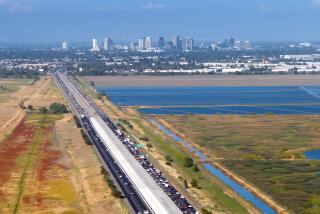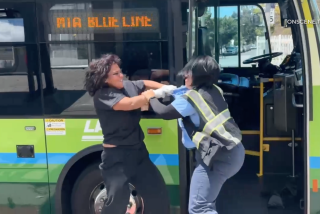Why Cars With Blacked-Out Windows Are on Road
- Share via
Dear Street Smart:
I know what the law says about blacked-out windows--they’re not allowed. But why is it not enforced? Why allow installers to continue selling the material under the guise that it’s legal?
I have seen TV commercials for new cars that show blacked-out windows. Ever try to guess where a driver you can’t make eye contact with at the stop is looking so you can proceed through the intersection safely? I have. It’s scary.
Robert Rocchio
Newport Beach
One certainly still sees a lot of cars zipping around Orange County with blacked-out windows. Personally, I find the things ominous-looking. Darth Vader would drive such a car.
As you note, these black-tinted windows are illegal in California. But that’s not the case in several other states, which explains why some manufacturers continue to air national TV advertisements showing cars with blacked-out windows.
In California, the rules are pretty straightforward. The law prohibits blacking out the front windshield and front-door windows. The rear windows may be tinted as long as the car is equipped with mirrors on both sides.
The vehicle code also forbids an auto shop or individual from selling or applying a substance that tints a window after a car has left the manufacturer. Unfortunately, a number of installers around the Southland continue to perform the service.
As a result, the California Highway Patrol writes a lot of tickets for cars with darkened windows. In January alone, 743 such tickets were written by the central Orange County office of the Highway Patrol.
Moreover, the agency has made some efforts to put the pinch on firms that perform the illegal after-market tinting. Two years ago, the Highway Patrol sent letters to auto tinters throughout the state requesting that they cease the practice, according to Angel Johnson, an agency spokeswoman in Santa Ana.
Unfortunately, the Highway Patrol has not followed up on that initial effort, an oversight that Johnson said results from a lack of manpower. As a result, she said, a number of the firms have continued to tint away, ignoring the law.
Some of the installers argue that they are putting on a “factory tint” and the service is therefore aboveboard. Others woo customers by saying the tint meets the law because the windows are not completely blacked out.
Johnson advises motorists to ignore such sales pitches. The law requires that the tinting be actually incorporated inside the glass, not something sprayed or laid on the exterior, she said.
While the tints help ease the impact of the sun inside a car, they also reduce a driver’s vision at night, Johnson said. The dark tinting also creates a problem for law enforcement officers, who cannot see what’s going on inside a car as they approach it after a stop, she said.
The bottom line is that motorists should beware. Tickets issued for the offense require that the tinting be removed from the car, which must then be checked out at a Highway Patrol office. And the cost of having the tinting professionally removed is not cheap.
Dear Street Smart:
Your answer on why bicyclists ride toward the outside of a bike lane (April 9) omitted one very important point. The lip of the road, where the asphalt ends and the concrete gutter begins, is one of the most dangerous places for a cyclist. A ridge is created by the rough intersection of the two surfaces.
This ridge is ideal for catching the thin tires of bicycles. If you are unlucky your bike will go crashing toward the pavement. Riding in the gutter is no option either, because it is too narrow to pedal in.
I drive much more than I bicycle, but I think drivers fail to understand that they must share the road with all different types of vehicles. Too many drivers, including myself, are impatient or running late, and expect to be able to go as fast as they want.
Jeff Mayer
Irvine
Dear Street Smart:
The ‘90s are here and life in Southern California continues to change, perhaps faster than some would like. The latest bike boom continues to attract more people to ride for exercise, transportation and plain fun. Given our often dismal status of health as well as the decreasing quality of our air, cycling has much to recommend it.
We have some of the finest off-road bicycle trails in the state, if not the nation. However, accident data collected shows that more cycle-related accidents occur on these facilities than on the public streets. Should we try to close bike trails? No, the trails are a lot of fun, despite the number of accidents. But we should do more to improve the skill of cyclists, preferably at early ages.
I also would like to add some words of support for the commuting bicyclists of Orange County. Bicycling commuters should be appreciated by all for reducing the number of cars on the road, eliminating petrochemical emissions and freeing up otherwise-occupied parking spots. Commuters on bikes are helping turn the tide of automotive dependency. They deserve our praise.
Michael Wellborn
Fountain Valley
These were just two of several letters and phone calls from bicyclists who wanted to voice their feelings about life on two wheels. In these days of Stage 2 smog alerts and hourlong commutes to trundle 10 miles, we should all be careful to steer a clear path around folks who venture out on cycles to get some exercise or maybe even get to work.
More to Read
Sign up for Essential California
The most important California stories and recommendations in your inbox every morning.
You may occasionally receive promotional content from the Los Angeles Times.










